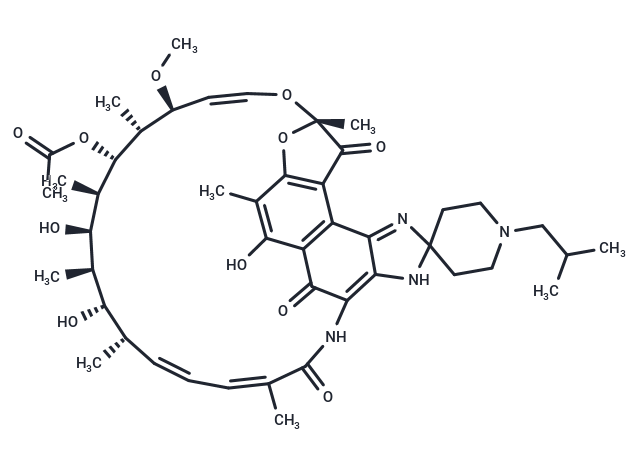Shopping Cart
- Remove All
 Your shopping cart is currently empty
Your shopping cart is currently empty

Rifabutin (LM-427) inhibits bacterial DNA-dependent RNA polymerase, thereby suppressing the initiation of RNA formation and leading to inhibition of RNA synthesis and transcription. Rifabutin is a semisynthetic ansamycin antibiotic with potent antimycobacterial properties.

| Pack Size | Price | Availability | Quantity |
|---|---|---|---|
| 10 mg | $30 | In Stock | |
| 25 mg | $42 | In Stock | |
| 50 mg | $55 | In Stock | |
| 100 mg | $79 | In Stock | |
| 500 mg | $238 | In Stock | |
| 1 mL x 10 mM (in DMSO) | $32 | In Stock |
| Description | Rifabutin (LM-427) inhibits bacterial DNA-dependent RNA polymerase, thereby suppressing the initiation of RNA formation and leading to inhibition of RNA synthesis and transcription. Rifabutin is a semisynthetic ansamycin antibiotic with potent antimycobacterial properties. |
| In vitro | In chimeric mice, the combined use of Rifabutin (100 mg/kg) and emtricitabine (10 mg/kg) resulted in a 75% survival rate among mice infected with either Toxoplasma or Plasmodium. Additionally, in these mice, Rifabutin significantly increased human CYP3A4 mRNA expression (by 7.4-fold), CYP3A4 protein levels (by 3.0-fold), testosterone 6β-hydroxylase activity (by 2.4-fold), and dexamethasone 6-hydroxylase activity (by 1.9-fold). |
| In vivo | Rifabutin exhibits broad-spectrum antimicrobial activity and, compared to rifampicin, demonstrates higher potency in vitro against the Mycobacterium avium complex (MAC), Mycobacterium tuberculosis, and Mycobacterium leprae. It is also effective against Group A Streptococcus, Campylobacter jejuni, Neisseria gonorrhoeae, Haemophilus influenzae, Staphylococcus species, Haemophilus ducreyi, Helicobacter pylori, Neisseria meningitidis, Chlamydia trachomatis, and Toxoplasma gondii. While rifabutin is active against most atypical mycobacteria, including Mycobacterium kansasii, it is less effective against Mycobacterium chelonae. Its isoenzyme selectivity closely resembles that of rifampicin, although rifampin induces to a greater extent, by 2-4 times. Furthermore, rifabutin enhances the glucuronidation of β-estradiol, 4-hydroxytamoxifen, and 1-naphthol by 2-3 times. |
| Alias | LM-427, Ansamycin |
| Molecular Weight | 847 |
| Formula | C46H62N4O11 |
| Cas No. | 72559-06-9 |
| Smiles | CO[C@H]1\C=C/O[C@@]2(C)Oc3c(C2=O)c2C4=NC5(CCN(CC(C)C)CC5)NC4=C(NC(=O)\C(C)=C/C=C\[C@H](C)[C@H](O)[C@@H](C)[C@@H](O)[C@@H](C)[C@H](OC(C)=O)[C@@H]1C)C(=O)c2c(O)c3C |
| Relative Density. | 1.339g/cm3 |
| Storage | Powder: -20°C for 3 years | In solvent: -80°C for 1 year | Shipping with blue ice/Shipping at ambient temperature. | |||||||||||||||||||||||||
| Solubility Information | Ethanol: 38 mg/mL (44.86 mM), Sonication is recommended. DMSO: 18.33 mg/mL (21.64 mM), Sonication is recommended. | |||||||||||||||||||||||||
Solution Preparation Table | ||||||||||||||||||||||||||
DMSO/Ethanol
| ||||||||||||||||||||||||||

Copyright © 2015-2025 TargetMol Chemicals Inc. All Rights Reserved.